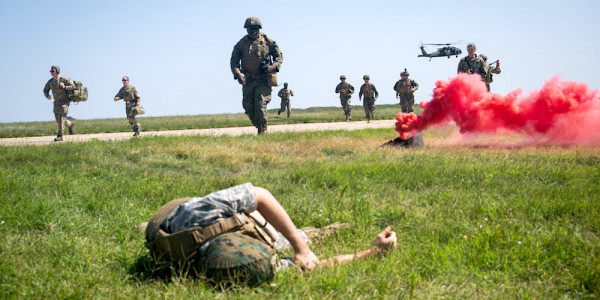

In 2009, the Department of Defense introduced the so-called ‘Golden Hour’ mandate. This led to the development of systems that ensured the injured warfighter access to surgical care within 60 minutes of injury.
This led to massive infrastructure being created in Iraq and Afghanistan, including the deployment of forward surgical teams, extensive medevac capabilities, and the in-country availability of advanced and specialized medical care. Undoubtedly, this saved many lives and has led to the expectation is that this is the standard.
But is this the future or even the present? The environment of conflict currently and in the coming years seems likely to look very different.
In the last few years, in order to maintain operational flexibility while still meeting the golden hour mandate, smaller versions of forward surgical teams (20-30 people and multiple surgeons) have developed. These include GHOST-T (Golden Hour Offset Surgical Treatment Teams) and ERST (Expeditionary Resuscitative Surgical Team) made up of a perhaps a single surgeon and less than 10 people.
With forward deployments consisting increasingly of embedded advisory and support roles rather than large missions with occupying forces, the demand for these teams have grown and the operation tempo has increased.
Therein lies the issue: Surgeons are being deployed to areas and in teams where their skills, experience, and ingenuity are expected overcome poor facilities and equipment and support. Because of their small size, in order to keep surgical capacity available for the warfighter, the deployed surgeon plays primarily a standby role with little operative experience. Unlike surgeons deployed in more robust settings who maintained skills in part by operating on host country nationals and providing some humanitarian care. Like in sports, practice is what makes perfect.
Frequent deployment without much operative experience combined with low volume, low acuity care when stateside makes military surgery increasingly unattractive. Surgeons, like athletes, want to be on the field and playing the game rather than sitting in the stands. This combined with the low surgical volumes of most military surgeons compared to their civilian counterparts and one can question how competency can be maintained.
Senior surgeons are leaving the Army in large numbers. Indeed, more than half of highly experienced general surgeons are reportedly leaving by retirement or separation in the coming year.
The number of citizen soldier surgeons in the reserves are also well below authorized numbers, resulting in little surge capacity and requiring active duty surgeons to cover this mission as well.
In short, surgeons with increasingly limited operative and trauma experience are expected to care for patients with potentially the most horrendous injuries, with minimal access to technology, equipment, and personnel to assist them.
What are the solutions?
First, the Mission Zero Act (H.R. 880) which will fund the embedding of military trauma teams into civilian trauma centers awaits passage through Congress. Also, expand the Military Health System Strategic Partnership American College of Surgeons (MHSSPACS) program, allowing increased civilian-military partnerships that support combat readiness. Explore new partnerships with humanitarian organizations and non-governmental organizations that may have resources on the ground in many current forward areas of operation. Contracted surgical assets may be another avenue to consider. And encourage and support the involvement of deployed surgical assets in the surgical care of host country nationals in order to maintain readiness in the deployed setting
What we need to do is balance the spirit of “Golden Hour” mandate, with its call for zero preventable deaths and public expectation of providing the highest possible quality of care regardless of location, with the reality of smaller footprints, immature deployments in nonpermissive environments, much less logistical infrastructure and a paucity of evacuation assets
Kai Engstad is a board-certified general and cardiothoracic surgeon. He is experienced in working in austere environments and conflict areas, including Kurdistan and Myanmar. He is interested in the intersection between military and civilian surgery in conflict zones.

